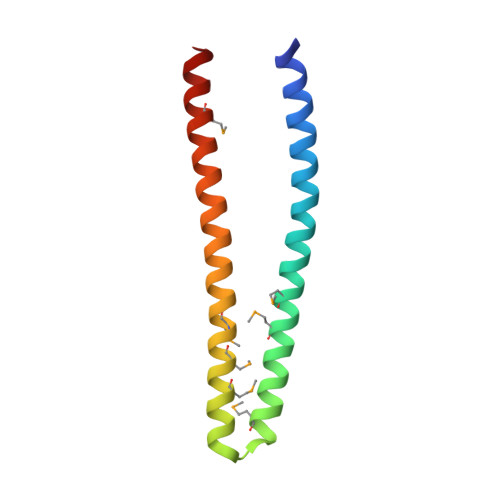Domain-swapped dimeric structure of a stable and functional de novo four-helix bundle protein, WA20
Arai, R., Kobayashi, N., Kimura, A., Sato, T., Matsuo, K., Wang, A.F., Platt, J.M., Bradley, L.H., Hecht, M.H.(2012) J Phys Chem B 116: 6789-6797
- PubMed: 22397676
- DOI: https://doi.org/10.1021/jp212438h
- Primary Citation of Related Structures:
3VJF - PubMed Abstract:
To probe the potential for activity in unevolved amino acid sequence space, we created a third generation combinatorial library of de novo four-helix bundle proteins. The "artificial superfamily" of helical bundles was designed using binary patterning of polar and nonpolar residues, and expressed in Escherichia coli from a library of synthetic genes. WA20, picked from the library, is one of the most stable proteins in the superfamily, and has rudimentary activities such as esterase and lipase. Here we report the crystal structure of WA20, determined by the multiwavelength anomalous dispersion method. Unexpectedly, the WA20 crystal structure is not a monomeric four-helix bundle, but a dimeric four-helix bundle. Each monomer comprises two long α-helices that intertwist with the helices of the other monomer. The two monomers together form a 3D domain-swapped four-helix bundle dimer. In addition, there are two hydrophobic pockets, which may potentially provide substrate binding sites. Small-angle X-ray scattering shows that the molecular weight of WA20 is ~25 kDa and the shape is rod-like (the maximum length, D(max) = ~8 nm), indicating that WA20 forms a dimeric four-helix bundle in solution. These results demonstrate that our de novo protein library contains not only simple monomeric proteins, but also stable and functional multimeric proteins.
- International Young Researchers Empowerment Center, Shinshu University, Ueda, Nagano 386-8567, Japan. rarai@shinshu-u.ac.jp
Organizational Affiliation:


















